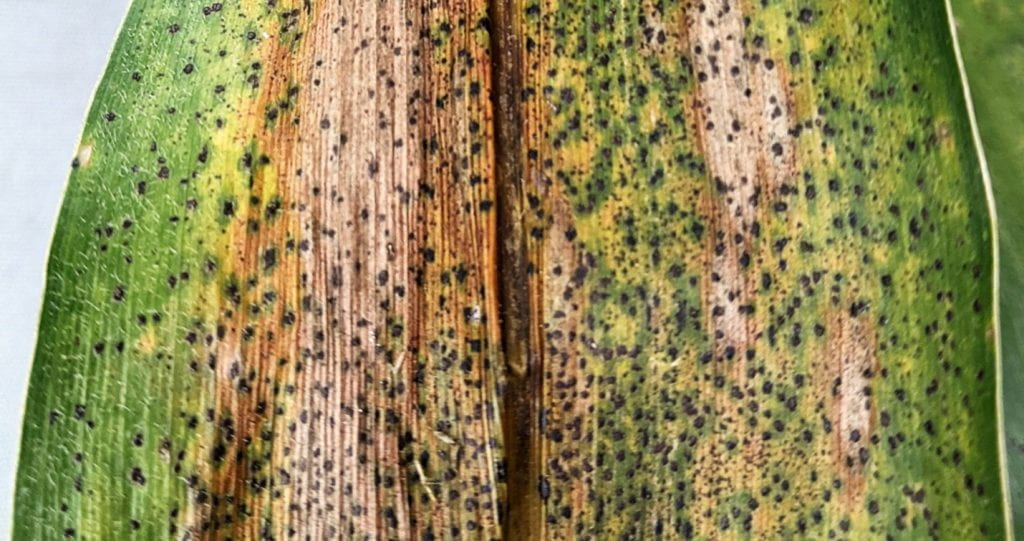Tar Spot Identified in Chautauqua County – From Gary Bergstrom
“Today (9/7/22), I confirmed the first observation of tar spot in New York in 2022. The occurrence was in southwestern Chautauqua County. This was in a field ready for silage harvest. Tar spot stromata were not evident two weeks ago but are prevalent now on lower and middle leaves and some on upper leaves. Tar spot is more prevalent on field borders than in the center of the field. The field was in silage corn in several previous years. Recent rains have been very conducive for tar spot development. This is an opportune time to scout corn fields, especially silage fields that may be harvested soon. Diagnosis is all about finding the raised black fungal stromata (see photo) which cannot be wiped or scratched off the leaf surface as insect frass can.”
We have not found Tar spot up in the NWNY region yet, but it may be time to really start looking for it. If you are out scouting and think you have found it, please let Jodi or Mike know and send us a picture. We can forward it on to Gary. If it looks positive, we would like to come out to the field and take some samples to send to Cornell.

Cover Crops Following Corn Silage
It’s September and the first corn silage fields are being chopped. What a difference a month can make when it comes to planting cover crops. Following winter wheat harvest, we had lots of options particularly in the first half of August. As we go past Labor Day, many of those crops such as clovers, peas, radishes, and oats, will not gain the biomass needed to be an effective fall cover. What’s left? Planting winter cereal grains are our best option after corn silage in NWNY.
Cereal rye is always the safest cover crop when it comes to establishment and biomass accumulation in the fall and spring. However, it can also be a nightmare in the spring if weather conditions do not allow for it to be sprayed, rolled or plowed under it a timely manner. Rye seed does germinate at the lowest soil temperatures and would be the best bet on those later harvested fields.
Winter wheat also establishes well in the fall and makes good cover. It does not grow as fast in the spring and therefore provides a wider window for management. Seeding rates for these cereals should be about 120 lbs. per acre (2 bushels).
Winter triticale is a hybrid between rye and wheat. It is the best option if you plan on harvesting the cover for forage in the spring. This has become a very popular option to increase forage inventories and has shown to be a good quality feed. Planting depth should be 1.25 to 1.5 inches deep at 100-120 pounds per acre. An additional PDF fact sheet on winter triticale forage can be found on Cornell’s Nutrient Management Spear Program website.
Getting Ready to Plant Winter Wheat
Riding around this week I saw some early maturity soybeans that had almost lost all their leaves. That means winter wheat is not far behind so here are a few quick reminders.
I get questions about the fly free dates every year. I have never seen Hessian flies in NY, but I guess that does not mean they are not here! I have been seeing more aphid transmission of Barley yellow Dwarf virus (fall yellows). Both pests are taken out by the first frost. Fly-free dates are determined based on altitude. For NWNY the date when it is safe to plant is roughly September 10 at 1200 ft, September 15 at 800 ft, and September 20 at 400 ft.
I have seen an increase in the number of wheat growers putting down starter fertilizer with great results! Phosphorus is very important and winter grains need 15 pounds for strong seedling establishment. Wheat also likes between 20-30 pounds of nitrogen at planting to promote fall tiller development.
Start off planting around 1.3 million seeds per acre in mid-September and increase population based on soil conditions and planting date.

Seeds per acre / # seeds/lb. = lb./acre Example: 1,450,000 / 13,000 = 111.5 lb./acre. Remember seeds per pound can vary from 9,000 to 16,000 seeds per pound so make sure you know your seed size.


